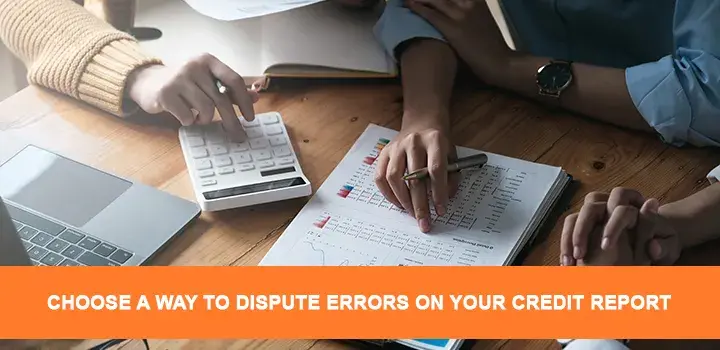-
Posted on: 21 Dec 2022

-
Discover the most effective methods to dispute errors on your credit report in 2025. This guide provides a clear, actionable roadmap to identify inaccuracies, understand your rights, and choose the best dispute strategy to improve your creditworthiness.
Understanding Your Credit Report and the Importance of Accuracy
Your credit report is a detailed history of your borrowing and repayment activities. It’s a critical document that lenders, landlords, employers, and even insurance companies use to assess your financial reliability. In 2025, the accuracy of this report is more crucial than ever. A clean and accurate credit report can unlock better interest rates on loans, easier approval for housing, and even lower insurance premiums. Conversely, errors, even minor ones, can have significant negative consequences, leading to rejections, higher costs, and a frustrating cycle of financial hurdles. Understanding what a credit report contains and why its accuracy is paramount is the first step in effectively managing your financial health and knowing how to choose a way to dispute errors on your credit report when they arise.
The three major credit bureaus in the United States – Equifax, Experian, and TransUnion – collect and maintain this information. Each bureau compiles a report based on data provided by various creditors, lenders, and public records. While these bureaus strive for accuracy, the sheer volume of data they process means that errors can and do occur. These errors can range from simple inaccuracies like incorrect personal information or misspelled names to more serious issues like accounts that don't belong to you, incorrect payment statuses, or duplicate entries. The impact of these errors can be substantial, affecting your ability to secure essential financial products and services. Therefore, regularly reviewing your credit reports and knowing how to address any discrepancies is a fundamental aspect of responsible financial management.
Identifying Common Errors on Your Credit Report
Before you can dispute an error, you must first be able to identify one. Errors on credit reports can manifest in various forms, and recognizing them is key to taking action. By understanding the common types of inaccuracies, you can more effectively scrutinize your reports and determine the best approach when you choose a way to dispute errors on your credit report.
Personal Information Inaccuracies
These are often the easiest to spot. They include:
- Incorrect Social Security Number (SSN) or date of birth.
- Incorrect current or previous addresses.
- Misspellings of your name or variations of your name that are not yours.
- Incorrect employment history.
While seemingly minor, incorrect personal information can sometimes lead to the misattribution of accounts or other more serious errors.
Account Inaccuracies
These are the most common and often the most impactful errors:
- Accounts that do not belong to you: This is a serious red flag, often indicating identity theft.
- Duplicate accounts: The same loan or credit card appearing multiple times.
- Incorrect account status: An account marked as delinquent, in collections, or charged off when it is current and in good standing.
- Incorrect payment history: Late payments reported that you know you made on time.
- Incorrect credit limit or balance: The reported limit or amount owed is wrong.
- Closed accounts still appearing as open, or vice versa.
- Incorrect date of last activity or date of first delinquency.
Public Record Inaccuracies
These errors relate to information from public records, such as bankruptcies, liens, or judgments:
- Outdated information: Public records that should have fallen off your report according to FCRA timelines are still listed.
- Incorrect details: Errors in the amounts, dates, or parties involved in a public record.
- Records that are not yours: A bankruptcy or lien filed against someone with a similar name.
Inquiries Inaccuracies
While generally less impactful, errors can still occur:
- Hard inquiries that you did not authorize.
- Too many inquiries listed in a short period, especially if they are not from you.
In 2025, with the increasing digitization of financial information, the potential for automated errors or data breaches leading to inaccuracies remains a concern. It is vital to review each section of your credit report meticulously. Pay close attention to the names of creditors, account numbers (the last four digits are usually shown), dates, balances, and payment histories. If anything seems amiss, it warrants further investigation.
Your Rights as a Consumer: The Fair Credit Reporting Act (FCRA)
Understanding your rights under the Fair Credit Reporting Act (FCRA) is fundamental when you choose a way to dispute errors on your credit report. The FCRA is a federal law that promotes the accuracy, fairness, and privacy of information in the files of the nation's credit reporting agencies. It empowers consumers with specific rights regarding the credit information collected about them.
Key Rights Under the FCRA:
- The Right to Access Your Credit Report: You are entitled to a free copy of your credit report from each of the three major credit bureaus (Equifax, Experian, and TransUnion) once every 12 months. You can obtain these at AnnualCreditReport.com. This is crucial for identifying errors.
- The Right to Dispute Inaccurate Information: If you find an error on your credit report, you have the right to dispute it with the credit bureau that generated the report. You also have the right to dispute the information directly with the company that provided the information to the bureau (the furnisher).
- The Right to Have Errors Investigated: Once you file a dispute, the credit bureau must investigate your claim, usually within 30 days (or 45 days if you provide additional information during the 30-day period). They must contact the furnisher of the information to verify its accuracy.
- The Right to Have Corrected Information Reinvestigated: If the investigation reveals that the information is indeed inaccurate, incomplete, or cannot be verified, it must be corrected or removed from your report.
- The Right to Add a Statement to Your File: If the dispute is not resolved to your satisfaction, you have the right to add a brief statement (up to 100 words) to your credit file explaining your side of the story.
- The Right to Know Who Has Accessed Your Credit Report: You can request a list of everyone who has accessed your credit report within a specified period (usually the last six months for employment purposes, and two years for other purposes).
- Protection Against Outdated Information: Most negative information, such as late payments, collections, and charge-offs, must be removed from your credit report after seven years. Bankruptcies can remain for up to 10 years.
In 2025, these rights remain the bedrock of consumer protection in credit reporting. Familiarizing yourself with these provisions will empower you to navigate the dispute process confidently and ensure that your credit report accurately reflects your financial history.
Choosing Your Way to Dispute Errors on Your Credit Report
When faced with inaccuracies on your credit report, you have several avenues to pursue. The best method for you will depend on the nature of the error, your comfort level with the process, and the amount of time you can dedicate. Understanding these options is crucial for effectively choosing how to dispute errors on your credit report.
The primary methods involve:
- Disputing directly with the credit bureaus (Equifax, Experian, TransUnion).
- Disputing directly with the creditor or data furnisher.
- Seeking assistance from a professional credit repair organization.
Each of these methods has its own advantages and disadvantages. The following sections will delve into each of these approaches to help you make an informed decision.
Method 1: Disputing Directly with the Credit Bureaus
This is the most common and often the most direct way to address errors. The FCRA mandates that credit bureaus investigate disputes. You can initiate a dispute with Equifax, Experian, or TransUnion online, by mail, or by phone.
Online Dispute Process:
All three major credit bureaus offer online dispute portals. This is generally the fastest method.
- Equifax: Visit the Equifax website and navigate to their consumer services section for disputes.
- Experian: Go to the Experian website and find their dispute resolution center.
- TransUnion: Access the TransUnion website and locate their online dispute form.
You will typically need to create an account and provide details about the error, including the specific account information and why you believe it is inaccurate. You can often upload supporting documents.
Mail Dispute Process:
For a more formal approach or if you prefer to keep physical records, you can send a dispute letter via certified mail. This provides proof of delivery.
- Address: Find the correct mailing address for disputes on each bureau's website.
- Content: Clearly state your name, address, SSN, and the specific account you are disputing. Explain the error and what you believe the correct information should be. Include copies (never originals) of any supporting documents.
- Certified Mail: Always send your letter via certified mail with a return receipt requested.
Phone Dispute Process:
While possible, disputing by phone is generally not recommended as the primary method. It's difficult to create a paper trail, and the information conveyed may not be as thoroughly documented as with written or online disputes. It can be useful for initial inquiries or to follow up on a written dispute.
Pros of Disputing with Bureaus:
- Directly mandated by FCRA: Bureaus are legally required to investigate.
- Fastest for common errors: Online portals are efficient.
- No cost involved.
- Builds a record of your efforts.
Cons of Disputing with Bureaus:
- Can be time-consuming if you have multiple errors across multiple reports.
- May require multiple rounds of communication.
- Bureau's investigation relies partly on information from the furnisher.
Method 2: Disputing Directly with the Creditor or Furnisher
The FCRA also allows you to dispute information directly with the company that reported it to the credit bureaus (the "furnisher"). This is often an effective first step, especially for errors that the furnisher can easily correct, like an incorrect balance or payment posting date. In 2025, this method is increasingly recognized as a powerful tool.
When to Use This Method:
- When you have a clear-cut error that the creditor can easily verify (e.g., a payment you made that wasn't credited, an incorrect balance).
- When you have already disputed with the bureau and the furnisher did not provide sufficient correction.
- When you want to try and resolve the issue directly and quickly before involving the bureaus extensively.
How to Dispute with a Creditor/Furnisher:
- Identify the Furnisher: This is the company that reported the information to the credit bureau (e.g., your credit card company, mortgage lender, auto loan provider).
- Send a Dispute Letter: Similar to disputing with bureaus, send a formal letter via certified mail.
- Content of the Letter:
- Clearly state your account number.
- Explain the specific error.
- Provide evidence to support your claim.
- Request that they investigate and correct the error with the credit bureaus.
- State that you are disputing under the FCRA.
- Follow Up: Keep records of all communication. If you don't receive a satisfactory response, you can then file a dispute with the credit bureaus, referencing your communication with the furnisher.
Pros of Disputing with Creditors/Furnishers:
- Potentially faster resolution: The furnisher can often correct errors directly without bureau intervention.
- More direct communication: You're speaking to the source of the information.
- Can be a good preliminary step.
Cons of Disputing with Creditors/Furnishers:
- Not all furnishers are equally responsive.
- They are not legally obligated to respond to you directly in the same way bureaus are to a dispute filed with them. However, they are obligated to report accurate information.
- Requires careful documentation.
Method 3: Seeking Professional Assistance
For complex cases, persistent errors, or if you lack the time or confidence to handle disputes yourself, professional credit repair services can be an option. These organizations specialize in identifying errors and navigating the dispute process on your behalf.
How Professional Services Work:
Reputable credit repair companies will typically:
- Obtain your credit reports from all three bureaus.
- Analyze them for inaccuracies.
- Send dispute letters to the credit bureaus and/or furnishers on your behalf.
- Communicate with these entities throughout the dispute process.
Choosing a Reputable Service:
It's crucial to be discerning, as the credit repair industry has historically seen its share of scams. In 2025, look for:
- Clear Fee Structures: Understand what you're paying for and when. Reputable services typically charge a monthly fee or a fee per deleted item. Be wary of companies that charge significant upfront fees.
- Transparency: They should clearly explain their process and what you can expect.
- No Guarantees: No legitimate service can guarantee the removal of all negative items, as only accurate information can remain.
- BBB Accreditation and Reviews: Check their reputation with the Better Business Bureau and look for independent reviews.
- Consumer Protection Laws: Be aware of the Credit Repair Organizations Act (CROA), which provides consumer protections.
Pros of Professional Assistance:
- Expertise: They understand the intricacies of credit reporting and dispute processes.
- Time-saving: They handle the communication and documentation.
- Can be effective for complex issues.
Cons of Professional Assistance:
- Cost: These services can be expensive.
- No guarantees: Success is not assured.
- Risk of scams: Choosing an unreputable service can be detrimental.
- You still need to be involved: You must provide necessary information and documents.
Ultimately, the choice between these methods depends on your individual circumstances. For most common errors, disputing directly with the bureaus or the furnisher is sufficient and cost-effective. Professional help should be considered a last resort for persistent or highly complex issues.
Gathering Essential Evidence for Your Dispute
Regardless of which dispute method you choose, strong evidence is your most powerful ally. When you choose a way to dispute errors on your credit report, you must be prepared to back up your claims. The more thorough and organized your documentation, the higher your chances of a successful resolution. In 2025, digital evidence is also increasingly accepted.
Types of Evidence to Collect:
- Proof of Payment: If you're disputing a late payment or collection, provide copies of canceled checks, bank statements showing the payment was made on time, money order receipts, or online payment confirmations.
- Account Statements: For incorrect balances, credit limits, or account statuses, provide statements from the creditor that show the correct information. If an account is closed but still showing open, provide the closure confirmation.
- Identity Verification: If you're disputing an account that isn't yours, provide documents that prove it. This could include a police report if you suspect identity theft, or documentation showing you've never lived at an address associated with the fraudulent account.
- Correspondence: Keep copies of all letters, emails, and notes from phone calls with creditors and credit bureaus regarding the disputed item. This includes return receipts for mailed letters.
- Contracts and Agreements: If the dispute involves terms of a loan or credit card agreement, have these documents handy.
- Public Records: If disputing a public record like a lien or judgment, obtain official court documents that show the error or that the record is not yours.
- Proof of Address Change: If an error is due to an old address being associated with your SSN, provide utility bills, driver's license, or lease agreements showing your current address.
Organizing Your Evidence:
A well-organized dispute package significantly strengthens your case:
- Create a Master File: Keep a dedicated folder (physical or digital) for all credit report-related documents.
- Categorize by Dispute: If you have multiple disputes, keep separate files or clearly label documents for each specific error.
- Make Copies: Never send original documents. Always send copies.
- Use a Cover Letter: For mail disputes, include a clear cover letter summarizing what you are disputing and listing the enclosed documents.
- Digital Organization: If submitting online, ensure your scanned documents are clear, legible, and in a common format (like PDF).
The more diligent you are in gathering and presenting evidence, the more persuasive your dispute will be. This preparation is a critical component of effectively choosing how to dispute errors on your credit report.
The Dispute Process: A Step-by-Step Guide
Navigating the dispute process can seem daunting, but by following a structured approach, you can manage it effectively. Here’s a comprehensive step-by-step guide to help you when you choose a way to dispute errors on your credit report, focusing on the most common method: disputing directly with the credit bureaus.
Step 1: Obtain Your Credit Reports
Before you can dispute anything, you need to know what's on your reports. In 2025, you are entitled to a free report from each of the three major bureaus (Equifax, Experian, TransUnion) annually via AnnualCreditReport.com. Request all three to ensure you catch discrepancies across all reports.
Step 2: Review Your Reports Meticulously
Compare the information on each report. Look for the common errors discussed earlier: accounts that don't belong to you, incorrect payment histories, wrong balances, outdated information, and incorrect personal details. Highlight or make notes of every discrepancy you find.
Step 3: Gather Supporting Documentation
For each error you identify, collect all relevant evidence. This could include bank statements, payment receipts, canceled checks, loan agreements, or any other document that proves the inaccuracy. (Refer to the "Gathering Essential Evidence" section).
Step 4: Decide on Your Dispute Method
Based on the nature of the error and your preference, decide whether to dispute online, by mail, or directly with the furnisher first. For most individuals, starting with an online dispute to the credit bureau is efficient.
Step 5: Initiate the Dispute
Online: Go to the respective credit bureau's website and follow their online dispute process. You'll typically need to create an account, select the account in question, and describe the error. You'll also have the option to upload your supporting documents.
By Mail: Draft a dispute letter. Include your full name, address, phone number, SSN, and the account details you are disputing. Clearly explain the error and why it is incorrect. Attach copies of your supporting documents. Send the letter via certified mail with return receipt requested to the correct dispute address for the bureau.
With Furnisher: If you choose to dispute with the creditor first, follow a similar letter-writing process, clearly stating the account number and the error, and sending it via certified mail.
Step 6: Document Everything
Keep copies of all dispute letters sent, all supporting documents submitted, and any responses received from the credit bureaus or furnishers. Note the date you sent each communication.
Step 7: Await the Investigation
Credit bureaus generally have 30 days to investigate your dispute. They will contact the furnisher of the information to verify its accuracy. If you provide additional information during this 30-day period, the investigation period can be extended to 45 days.
Step 8: Review the Investigation Results
After the investigation, you will receive a response from the credit bureau. This will either confirm that the error has been corrected, or that the information was found to be accurate. If the error was corrected, review your updated credit report to ensure the change is accurate.
Step 9: Follow Up or Escalate (If Necessary)
If the error is not corrected or you believe the investigation was insufficient:
- Contact the Furnisher Again: If you initially disputed with the bureau, try disputing directly with the furnisher.
- Send a Re-Dispute Letter: If new evidence has emerged, you can submit a re-dispute.
- Add a Consumer Statement: If the dispute is not resolved to your satisfaction, you can add a statement to your credit file explaining your position.
- Consider Professional Help: If you continue to face issues, a credit repair professional might be beneficial.
- File a Complaint: You can file a complaint with the Consumer Financial Protection Bureau (CFPB) if you believe the credit bureau or furnisher has violated your rights under the FCRA.
This systematic approach ensures that you cover all necessary steps and maximize your chances of success when you choose a way to dispute errors on your credit report.
What Happens After You Dispute an Error?
Once you've initiated a dispute, a series of actions are set in motion by the credit bureaus and the data furnishers. Understanding this post-dispute process is crucial for managing expectations and knowing what to anticipate in 2025.
The Bureau's Investigation:
Upon receiving your dispute, the credit bureau will:
- Acknowledge Receipt: They will typically acknowledge your dispute, especially if it's filed online.
- Forward the Dispute: The bureau will forward your dispute, along with any supporting documentation you provided, to the company that reported the information (the furnisher). This usually happens within 5 business days of receiving your dispute.
- Furnisher's Verification: The furnisher then has a limited time (typically 30 days) to investigate the disputed item. They must review their records and determine if the information they reported is accurate.
- Report Back to the Bureau: The furnisher will report their findings back to the credit bureau.
Outcomes of the Investigation:
There are several possible outcomes:
- Error Corrected: If the furnisher confirms the information is inaccurate, they will correct it with the credit bureau. The bureau will then update your credit report accordingly and send you an updated report reflecting the changes.
- Information Verified as Accurate: If the furnisher verifies that the information is accurate, it will remain on your credit report. The credit bureau will notify you of this outcome.
- Information Cannot Be Verified: In some cases, the furnisher may not be able to verify the information. In such instances, the disputed information must be removed from your credit report.
- Removal Due to Lack of Response: If the furnisher fails to respond to the credit bureau's inquiry within the allotted time, the disputed item is typically removed from your report.
Your Rights and Next Steps:
- Notification: You will receive a written notice of the results of the investigation from the credit bureau.
- Updated Credit Report: If corrections are made, you will receive a revised credit report.
- Consumer Statement: If the dispute is not resolved to your satisfaction and the information remains on your report, you have the right to add a statement (up to 100 words) to your file explaining your position. This statement will be included in future credit reports provided to potential lenders.
- Further Action: If you believe the credit bureau or furnisher has violated your rights under the FCRA, you can file a complaint with the Consumer Financial Protection Bureau (CFPB) or consult with an attorney specializing in consumer law.
The process is designed to be thorough, but it relies on the cooperation and accuracy of both the credit bureaus and the furnishers. Persistence and meticulous record-keeping are key to a successful outcome when you choose a way to dispute errors on your credit report.
Preventing Future Errors on Your Credit Report
While disputing errors is essential, proactive measures can significantly reduce the likelihood of them appearing on your credit report in the first place. In 2025, adopting these habits will contribute to a more stable and accurate credit profile.
Regularly Monitor Your Credit Reports
As mentioned, obtain your free credit reports annually from AnnualCreditReport.com. Some services also offer free credit monitoring, which can alert you to significant changes on your report, including new accounts or inquiries.
Ensure Accurate Personal Information with Creditors
When you open new accounts or update your information with existing creditors, double-check that your name, address, SSN, and date of birth are entered correctly. Even small typos can lead to confusion and errors.
Maintain Good Financial Habits
The most common errors relate to payment history and account status. By:
- Paying bills on time: Set up automatic payments or reminders.
- Keeping balances low: Avoid maxing out credit cards.
- Not opening too many new accounts at once: This can be a red flag and increases the chance of administrative errors.
you reduce the instances where creditors might misreport your account status.
Be Cautious with Identity Theft
Identity theft is a major cause of fraudulent accounts appearing on credit reports. Protect your personal information by:
- Using strong, unique passwords for online accounts.
- Being wary of phishing scams.
- Shredding sensitive documents before discarding them.
- Monitoring your financial accounts regularly for suspicious activity.
Understand Credit Reporting Cycles
Creditors typically report to credit bureaus once a month. If you make a payment or close an account, it may take a billing cycle or two to reflect accurately on your report. Understanding this timing can prevent unnecessary disputes.
Communicate with Creditors
If you anticipate difficulty making a payment, contact your creditor immediately. They may be able to offer a payment plan or deferment, which can prevent a delinquency from being reported to the credit bureaus.
By incorporating these preventative strategies into your financial routine, you can significantly minimize the chances of encountering errors and maintain a healthy, accurate credit report, making the process to choose a way to dispute errors on your credit report a less frequent necessity.
In conclusion, understanding and actively managing your credit report is a cornerstone of financial well-being in 2025. When errors do occur, knowing your rights under the FCRA and having a clear strategy for dispute resolution is paramount. Whether you opt to dispute directly with the credit bureaus, engage with the creditors themselves, or seek professional guidance, the key lies in meticulous documentation, clear communication, and persistent follow-up. Regularly reviewing your reports and implementing preventative measures will further safeguard your creditworthiness. By taking these steps, you empower yourself to maintain an accurate credit history and unlock the financial opportunities it represents.










